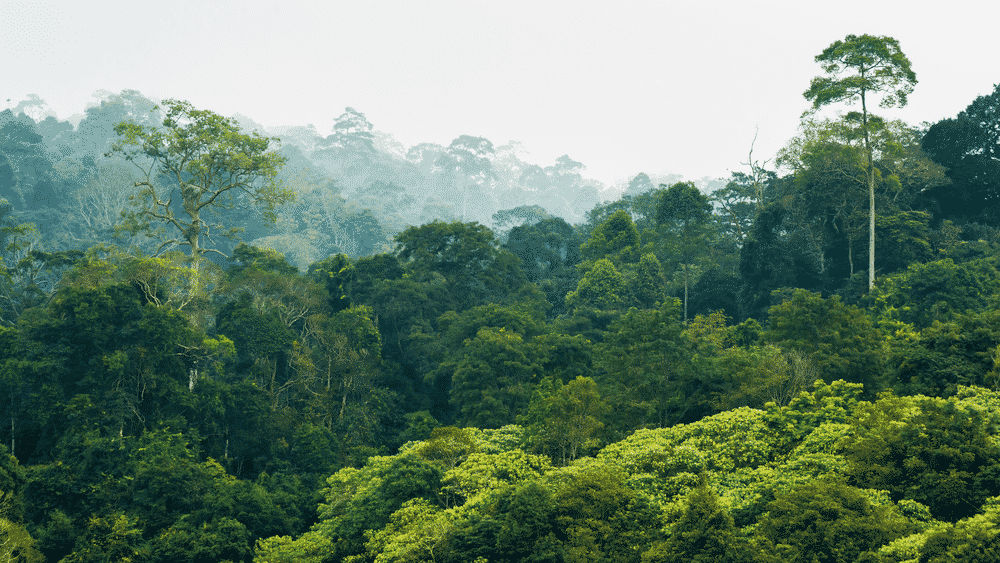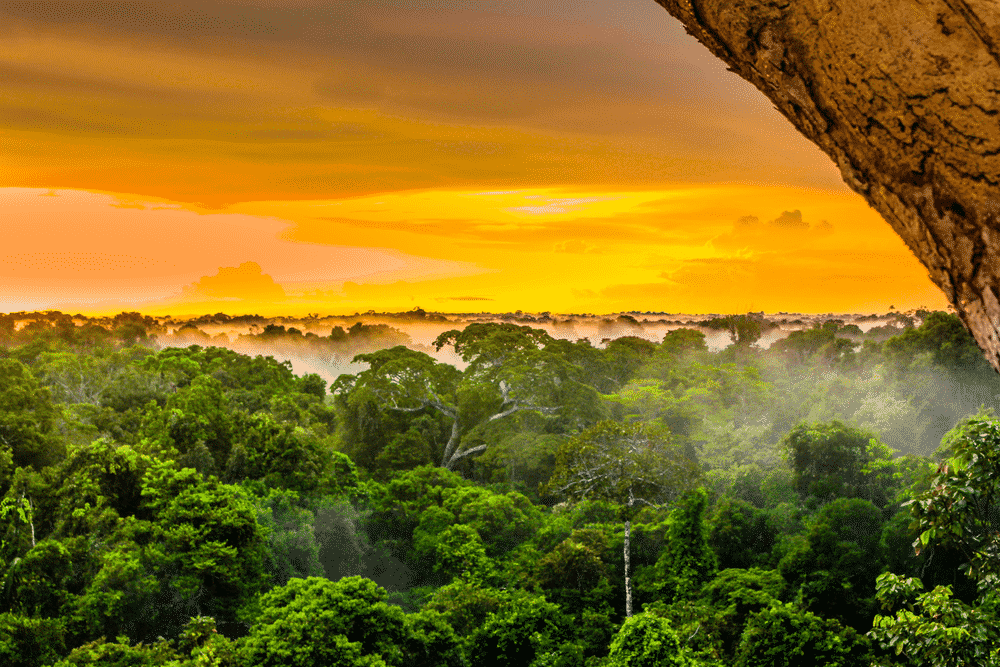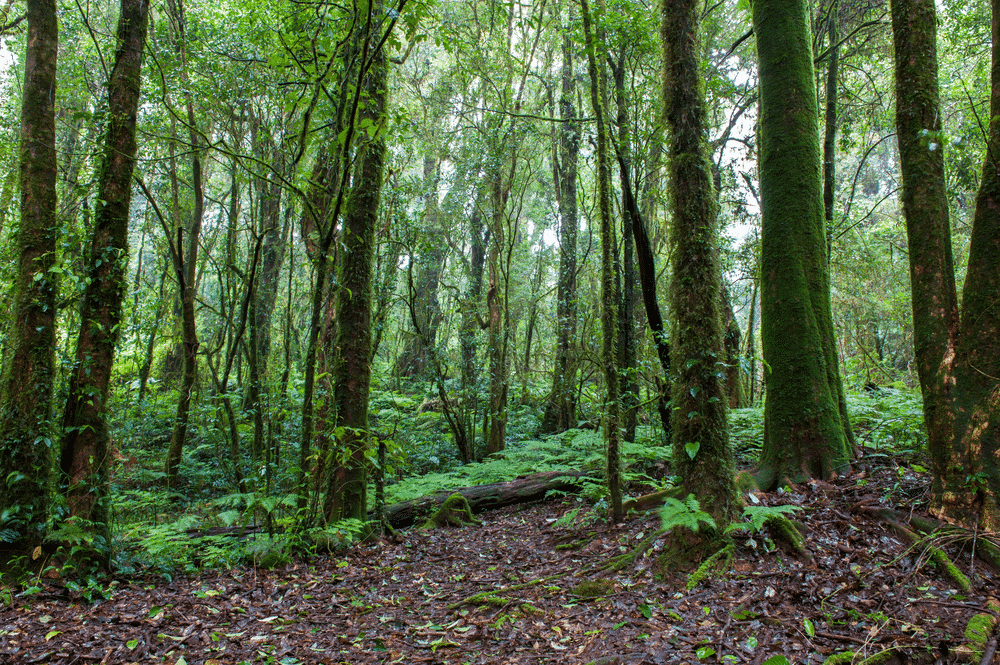A rainforest is a high-density grouping of tall trees and other vegetation, in which the tall trees from a dense canopy which significantly reduces lights levels at the forest floor. Many of the trees in the rainforest will be evergreens with relatively soft leaves and these trees will have the ability to reproduce under the undisturbed canopy.
However, the rainforest may also include numbers of conifers and hard-leaved evergreens. As these species do not usually have the ability to reproduce under the canopy they may be relics from previous disturbances or be found mainly around the edge of the rainforest.
Most tourists interested in nature, rainforests are about the most attractive biome on Earth. Tourists often see rainforests as lush, luxuriant, vibrant, immense, mysterious, spiritual, and romantic. As most tourists are urban-dwellers from countries without rainforests, a visit to a rainforest is an exotic and rare experience.
Rainforests are also associated with other attractive experiences and images. Tropical beaches, islands, and resorts are easily associated with rainforests. Rainforests hold a special place for some as the landscapes of the dinosaurs.
Today, rainforests are the home of exotic, rare and threatened species such as the mountain gorillas of Africa and the orang-utans of Sumatra.
With increased interest over the last 20 years in the preservation of the environment, the fate of the rainforests, especially those of the Amazon basin has become symbolic of that struggle. For most tourists, a visit to a rainforest is an affirmation of their support for the environment.
What are Rainforests?
Defining rainforests generally is simple, defining them exactly is very difficult and has generated much debate. The term rainforest was coined in 1898 by the German botanist Andreas Schimper in his Plant-Geography upon a Physiological Basis.
He described dense lush tropical forests which he had visited on fieldwork in the Caribbean. These forests only occurred in areas of high rainfall. Thus, he combined rain and forests for the term Regenwald, which was quickly translated into English as Rainforest.
Difficulties arose when other high rainfall forests around the globe were considered. Some were structurally similar to Schimper’s tropical rainforest but occurred in subtropical, temperate and even cold temperate climates. Other tall, dense forests occurred in high rainfall areas but seemed substantially different in structure.
In confusion, rainforests were often defined in a negative way. Schimper and his fellow botanists were mainly European and North Americans, they already know about the high rainfall conifer and deciduous forests of their home country, they were describing different forests, so they defined rainforest in a Eurocentric way as evergreen broadleaf forest.
In Australia, some botanists defined rainforests as forests in high rainfall areas which were not eucalypt forests. Similarly, on the west coast of the USA, it was decided that the redwood forests were not rainforests.
Different botanists define the rainforest based on forests which were available into there geography. Bearing all these difficulties in mind, it is possible to construct a generally acceptable definition of the rainforest.
A rainforest is a high-density grouping of tall trees and other vegetation, in which the tall trees from a dense canopy which significantly reduces light levels at the forest floor.
Types of Rainforest
There are a number of different ways of classifying rainforests, the following is probably the most common. Though it uses a nomenclature which suggests typology based on climate, the differences are really much more of a structural nature.
Tropical Rainforest
 This is the original rainforest as described by Schimper, the most common type and the stereotype of rainforest firmly lodged in the mind of most tourists. Its chief characteristics are:
This is the original rainforest as described by Schimper, the most common type and the stereotype of rainforest firmly lodged in the mind of most tourists. Its chief characteristics are:
- A very wide diversity of tree and plant species. Even though tropical rainforests only cover 7% of the Earth’s landmass, they provide about 50% of the world’s plant species.
- A very dense canopy, often multilayered, sometimes with a fairly open understorey at ground level.
- Most trees have very large leaves and often massive buttress roots.
- A large number of thick, woody vines, palms and epiphytes.
Tropical rainforest primarily requires warm temperatures and secondarily high rainfall. Half of the world’s tropical rainforests are in the Americas, particularly Central America, the Caribbean and the northern third of South America.
Subtropical Rainforest
 Subtropical rainforest occurs adjacent to tropical rainforest in areas that are slightly cooler due to the difference in altitude or latitude. Subtropical rainforest looks very similar to the tropical rainforest but is somewhat less luxuriant and diverse.
Subtropical rainforest occurs adjacent to tropical rainforest in areas that are slightly cooler due to the difference in altitude or latitude. Subtropical rainforest looks very similar to the tropical rainforest but is somewhat less luxuriant and diverse.
It is dominated by only a few tree species and it is less layered. Buttresses, figs, palms, large epiphytes, and woody vines may be less frequent and there may be more ferns.
An interesting and confusing variation occurs with rainforest on less fertile and acidic soil. Even though it may be adjacent to the subtropical rainforest, this depauperate type is called warm temperate rainforest.
It is typically dominated by one or two species, trees are shorter, leaves are smaller and has far less tropical rainforest characteristics.
Dry or Monsoonal Rainforest
 Usually contiguous to tropical and subtropical rainforests, these are rainforest markedly affected by a pronounced dry season. They are characterized by species typically found in the other rainforests, but which have adapted to the more seasonal conditions.
Usually contiguous to tropical and subtropical rainforests, these are rainforest markedly affected by a pronounced dry season. They are characterized by species typically found in the other rainforests, but which have adapted to the more seasonal conditions.
This adaptation might include dwarfing or a limited growing season. Such rainforest is typically more open with far less luxuriant foliage. They may be dominated by more drought tolerant rainforest species, such as araucarian conifers.
In some instances, small patches of dry rainforest may be found along watercourses and in gorges in regions that are normally considered quite arid.
The subtropical, warm temperate and dry or monsoonal rainforests extend significantly outwards from the tropical rainforest cores of Central-South America, West Africa, and Southeast Asia.
Cool Temperate Rainforest
 Cool temperate rainforests do not really match the stereotypes of rainforests. They lack the diversity and luxuriance of tropical rainforests. They are usually cold and wet and therefore unattractive to some tourists. They look far more like European forests.
Cool temperate rainforests do not really match the stereotypes of rainforests. They lack the diversity and luxuriance of tropical rainforests. They are usually cold and wet and therefore unattractive to some tourists. They look far more like European forests.
In the last few decades, they have come to occupy a special niche for rainforest lovers. In a way that tropical rainforests are not, cool temperate rainforests are seen as real wild places, a sort of the last frontier.
Being cold and wet they are usually not in close proximity to intensive cultivation or large densities of humans. Cool temperate rainforests are geographically distant from the other rainforests.
Cool temperate rainforests are mainly found in the southern half of the southern hemisphere, namely Chile, Tasmania, and New Zealand. The chief characteristics of cool temperate rainforests are:
- One dominant tree variety; usually Nothofagus.
- Very small leaf size; sometimes deciduous.
- Buttresses, palms, figs, large epiphytes and woody vines completely absent.
- Abundant ferns, mosses, and lichens.
Some writers, mainly from the northern hemisphere, refer to cool temperate rainforests as montane rainforests and to tropical and subtropical rainforests as lowland rainforests.
Evolution of Rainforests
Schimper in 1898 only discovered a rainforest in a Eurocentric sense, by naming them. The far longer history of rainforests has really only been pieced together more recently
Their origins are in the great southern supercontinent Gondwanaland which existed between 160 and 100 million years ago and consisted of modern-day South America, Southern Africa, India, Australia, and Antarctica.
In a world much warmer and wetter than today, Gondwanaland developed as a rainforest continent. The Gondwanan dinosaurs grazed in an extensive and lush environment of conifers, ferns, palms, and cycads.
About 125 to 100 million years ago flowering plants began to develop, probably as opportunists filling newly created ecological niches as sea level varied. At around the same time, Gondwanaland began to break apart, some parts drifting off to collide with the northern supercontinent Laurasia and other parts remaining separate.
Today’s rainforests are either found on former parts of Gondwanaland or in regions of close proximity. The break up of Gondwanaland was accompanied by global cooling and drying, which was particularly manifested in the development of polar ice caps and irregular Ice Ages.
This caused rainforests to evolve their cool temperate form and prevented their spread into Europe and temperate North America. Indeed increased understanding of out botanica history reverses traditional Eurocentric views. The supposedly ancient forests of Europe are really posted Ice Age youngsters
Rainforest Tourism
Rainforest tourism is very difficult to quantify and package neatly. There are major problems in defining rainforest tourists and counting them. Do we define by interests, activities or attractions visited? Do we count numbers or revenue yielded?
As we are a long way off quantifying rainforest tourism and there has been very little research specifically on rainforest tourism, the approach taken here is descriptive and somewhat speculative.
The most significant development in rainforest tourism in recent decades has been the growth of high-value package tours. These have been particularly noticeable in Latin America, most notably Costa Rica, but also Guatemala, Honduras, Belize, Mexico, and Brazil.
Tour also occur to a lesser extent in most of the rainforested areas of the world, although political instability and warfare have severely limited their development.
The market for this type of rainforest tourism is typically relatively well to do tourists from well-developed countries, especially from the USA and northern Europe. Such tourists fit the classic ecotourism mold, they are generally well educated, keen to incorporate learning experience into their holiday and concerned about conservation.
Much of the high-value rainforest tourism is through traditional style group tours. These are typically 7-14 days, all inclusive of food, accommodation, and attractions, often cover a large area and a number of countries and are usually built around a strong theme.
Rainforests are not the sole attraction for these tourists. They may be interested in a range of attractions which are geographically linked to the rainforest, or it may even be that the rainforest is just the background for a far stronger interest.
A different form of rainforest tourism has tended to develop in Australia, particularly in Queensland. It is chiefly distinguished by its markets. In Queensland, they are chiefly domestic tourists, international visitors from Asia and backpackers.
Prices are lower and packages are built around accommodation destinations rather than long tours. These accommodation destinations skillfully use rainforest plantings and views as their setting. Nonetheless, the rainforest is typically a background for the tourists’ chief interests in beaches, water activities, and adventure experiences.
The Artificial Rainforest
Another recent tourist development is the artificial rainforest. As rainforests are highly attractive, but expensive to visit, some developers have taken the approach of bringing the rainforest to the city rather than vice versa.
It is interesting to note that one key tourism textbook only refers to rainforest attractions in this sense, citing the case of the indoor Lied Jungle in Nebraska, USA, which attracts 1.3 million visitors annually.
Such development is highly dependent on technology, either to create realistic artificial copies or to keep real specimens alive. Their massive cost requires very large numbers of visitors paying small entry fees. Generally, they provide an hour or two of interest and are directly competing with a wide range of similarly prices accessible attractions.
Whether or not they are financially viable in the long term remains to be seen. What is also uncertain is whether or not this urban alternative affects demand for real rainforest tourism.